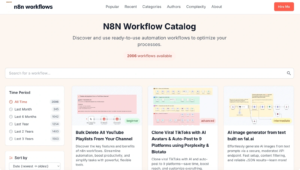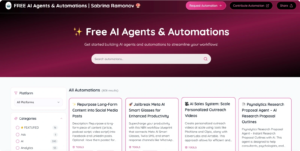Firstly, if you find it troublesome to build your own system, you can easily use the official solution .Just Click here
As a powerful community-driven open-source automation platform, n8n has won the favor of numerous developers worldwide due to its excellent openness and flexibility. Within the n8n community, a vast array of free templates are readily available, covering a comprehensive range of application scenarios from daily data synchronization and customer relationship management (CRM) integration to popular social media automation and search engine optimization (SEO), spanning various industries.
To help everyone get started quickly, Xiangyu has specially curated six high-quality resource entries for you today, which support one-click download of JSON configuration files without requiring registration. This will allow you to easily embark on your automation journey! Of course, although there are many templates, they are only a starting point. The real value lies in flexibly customizing and adjusting them according to your actual business needs. By deeply learning in the specific practice process and continuously improving practical operations through learning, you can truly unleash the powerful potential of n8n and empower your business growth through automation!
Download link (click) extraction code: zVsT
1. n8n official template library

https://n8n.io/workflows
Platform nature: Officially hosted
Template classification: 20+ categories (AI, marketing, IT operation and maintenance, sales, development, human resources, etc.)
Target audience: Beginners, professional users
Update and maintenance: Continuous updates, with ~2100 templates currently included
Community interaction: The community contributes through the Creator Program, and the official provides statistics such as viewership and downloads
- Highlight: One-stop official examples, all templates can be downloaded with one click without logging in, either as JSON files or on n8n Cloud
Load in; the page displays a “Use for free” button, allowing direct access to the configuration.
- Recommendation: Ideal for beginners with no prior experience, offering a comprehensive range of templates; backed by an official incentive program to ensure continuous innovation.
II. N8N Workflows Catalog

URL:
Platform nature: Third-party image
Template classification: Consistent with the official library (by AI, design, finance, human resources, etc.), and supports difficulty grading
Target audience: All users, especially newcomers who pursue efficient filtering
Update and maintenance: Automatically synchronize official repository data, and pull new/updated data in real time
Community interaction: No comment function, but provides metrics such as download volume and popularity
- Highlight: Friendlier classification and search functions than the official ones, supporting sorting by “difficulty”, “node type”, and “download count”
Multi-dimensional filtering options such as “Newest Additions”; no login required, simply click “Download workflow on n8n.io” to redirect to the official page or directly download the JSON.
- Recommended for: An ideal choice when faced with a plethora of official templates and difficulty in filtering; lightweight, easy to use, and covers all scenarios.
III. Awesome n8n Templates (GitHub)

URL:
https://github.com/enescingoz/awesome-n8n-templates
Platform nature: Community open-source repository
Template classification: 10+ categories (email automation, chatbots, office documents, social media, AI/LLM, human resources, databases, etc.)
Target audience: n8n enthusiasts, technical researchers
Update and maintenance: Regularly collect public online resources, currently including over 250 templates
Community Interaction: 2.5k collections, 600+ forks, accepting Issues/PR
- Highlights: Fine classification by function and integration type, with all JSON files available for direct download or cloning from the repository;
The README file provides explanations on the sources and licenses of each template.
- Recommended for: Those who want to conduct in-depth research on specific service integrations (such as Gmail, Slack, Twitter, OpenAI, etc.); it allows for custom extensions and community contributions are continuously being made.
IV. n8n Free Templates by Jayanth (GitHub)

URL:
https://github.com/wassupjay/n8n-free-templates
Nature of the platform: Personal project
Template classification: 25 industries (AI/ML, email, social media, finance, e-commerce, education, healthcare, DevOps, IoT)
(including websites, etc.) a total of 200 templates
Target audience: Developers with certain experience, and advanced users with specific use case requirements
Update and maintenance: The initial release includes a full set of 200 examples, with subsequent updates depending on the author’s willingness
Community interaction: ~78 favorites, contributions via PR are welcome
- Highlights: Plug-and-Play templates that work right out of the box, with built-in instruction documents, error handling, and prompts for each workflow; some templates also incorporate advanced features such as RAG knowledge bases, OCR, and vector retrieval.
- Recommendation: Users who pursue one-stop industry solutions and wish to learn about the integration of AI and automation scenarios should not miss this.
5. Marvomatic n8n Templates (GitHub)

URL:
https://github.com/Marvomatic/n8n-templates
Platform nature: Personalized and specialized project
Template classification: SEO and content optimization (keyword mining, traffic analysis, Google Search Console reports, AI writing, SERP tracking, etc.)
Target audience: Website operators, SEO/content practitioners
Update and maintenance: Continuously adding free templates while offering paid premium plans
Community interaction: ~578 collections, 167 forks, interacting with the author through Issues/Discussions
- Highlights: Closely addressing SEO business pain points, generating reports in a batch and intelligent manner; integrating Google Drive, Webhooks, and API calls in the example, suitable for building a complete SEO automation workflow.
- Recommendation: High-quality templates in specialized fields, niche yet practical; assisting content creators and marketing teams in automating and enhancing efficiency.
-
Free AI Agents & Automations (agents.sabrina.dev)

URL:
Nature of the platform: Community aggregation, open-source directory
Resource type: Various AI Agent templates and automated recipes
Target audience: Those who need to seamlessly integrate AI Agents into platforms such as n8n and Make
- Filter by tag: Multiple platforms (n8n, Make) can be selected
- Keyword search: global title/description search
Summary
The above six major n8n free resource websites cover everything from beginner-level tutorials to industry-level advanced use cases, ranging from official authoritative resources to community innovations. No registration is required, and JSON downloads are supported with a single click.
- Recommendation for beginners: Prioritize browsing the official n8n template library to quickly find suitable examples.
- Advanced users: Dive deep into over 200 industry examples from Awesome n8n Templates, n8n Free Templates by Jayanth, and Free AI Agents & Automationsto learn various integration methods.
Safety reminder: Before importing third-party templates, please be sure to check the node configuration and script content to prevent sensitive information leakage or potential risks.
Utilize these free templates to assist you in constructing multi-scenario automated workflows with minimal cost and maximum speed, enabling both individuals and teams to work efficiently!